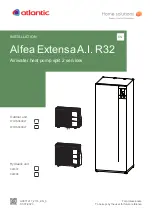
■
Installation and maintenance rules
The appliance must be installed and maintained
by an approved professional in accordance with
current regulations and codes of practice.
• Do not use any means to accelerate the
defrosting process or to clean the appliance,
other than those recommended by the
manufacturer.
• The appliance must be stored in a room that
does not contain continuously operating
ignition sources (for example: open
fl
ames,
gas appliance or operating electric heater).
• Do not pierce or burn.
• Be careful, refrigerants can be odorless.
■
Handling
The outdoor unit must not be placed in a horizontal
position during transport.
If not kept upright during transport, the appliance
could be damaged through displacement of
the refrigerant and damage to the compressor
suspensions.
Any damage caused by transportation in a horizontal
position is not covered by the warranty.
If necessary, the outdoor unit may be tilted only
during manual handling (to go through a door or to
take a stair). This operation must be conducted very
carefully and the appliance must be immediately
restored to the upright position.
■
Installation
The heat pump installation must meet the
requirements related to the location of the heat
pump.
The heat pump is designed to be installed at less
than 2000 m altitude.
In accordance with IEC 60-335-2-40 standard, the
hydraulic module of the heat pump as well as all
the refrigerant connections that cross the inhabited
area must be installed in rooms respecting the
minimum surface.
• Warning, hydraulic unit should not be installed
in an air current.
■
Refrigerant
The maximum R32
fl
uid load after re
fi
lling must not
exceed 1.84 kg.
■
Containment of refrigeration circuits
All refrigeration circuits are sensitive to dust and
moisture contamination. If any such pollutants
penetrate the refrigeration circuit, they can a
ff
ect
the reliability of the heat pump.
•
Make sure that the connections and
refrigeration circuits (hydraulic unit, outdoor
unit) are protected correctly.
• In the event of a subsequent failure and
following an inspection, the presence of
moisture or foreign bodies in the compressor
oil would automatically void the warranty.
- Check upon receipt that the
fi
ttings and refrigeration
circuit caps mounted on hydraulic unit and outdoor
unit are properly seated and secured (cannot be
loosened with bare hands). If this is not the case,
tighten them using a C spanner.
- Check also that the refrigeration connections are
sealed (plastic caps or tubes crimped at the ends
and brazed). If the caps must be removed during
the installation (tubes to be re-cut for example),
put them back as soon as possible.
■
Hydraulic connections
The connection must comply with industry standard
practice according to current regulations.
Reminder: Seal everything when
fi
tting in accordance
with industry standard practice for plumbing work:
- Use suitable seals (
fi
bre gasket, O-ring).
- Use Te
fl
on or hemp tape.
- Use sealing paste (synthetic depending on the
case).
Use glycol/water mix if the minimum
fl
ow
temperature is set below 10°C. If you are using a
glycol/water mix, arrange for an annual check on
the quality of the glycol. Use monopropylene glycol
only. The recommended concentration is 30%
minimum.
Never use monoethylene glycol.
• In some installations, the presence of di
ff
erent
metals can cause corrosion problems;
the formation of metal particles and sludge can
appear in the hydraulic circuit.
• In this case, it is advisable to use a corrosion
inhibitor in the proportions indicated by the
manufacturer.
• You must also ensure that treated water does
not become corrosive.
On the cold water inlet, place a safety valve
calibrated to between 7 and 10 bar max. (depending
on local regulations) and connected to a drain
pipe leading to the sewer. Operate the safety
valve according to manufacturer's speci
fi
cations.
The domestic hot water tank must be fed with cold
water passing through a safety valve. There must
be no other valves between the safety valve and
the tank.



































